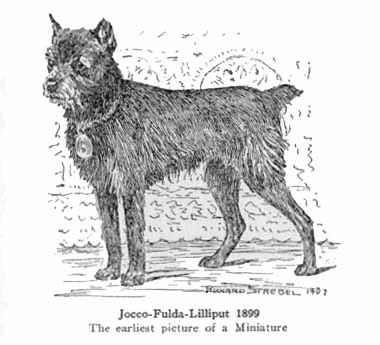 The Standard Schnauzer is the progenitor of the other two Schnauzer
varieties, the Miniature and the Giant. There
has never been any breed or variety of Schnauzer that was considered a Toy
Schnauzer. Anyone representing their dog as a Toy Schnauzer is
attempting to breed small Miniature Schnauzers which could lend itself to
whelping and other problems due to their small size.
The Standard Schnauzer is the progenitor of the other two Schnauzer
varieties, the Miniature and the Giant. There
has never been any breed or variety of Schnauzer that was considered a Toy
Schnauzer. Anyone representing their dog as a Toy Schnauzer is
attempting to breed small Miniature Schnauzers which could lend itself to
whelping and other problems due to their small size.
It is probable that the Doberman, Rottweiler, and the Standard Schnauzer had a common source in a Wurttenberg cattle dog, and crossing to the Manchester Terrier produced the Doberman, and some other cross (perhaps Spitz and Poodle) gave the Schnauzer his characteristic color and coat. There are paintings depicting Schnauzers from the fifteenth and seventeenth centuries.
The Schnauzer’s original vocation was that of a stable, yard, and cattle dog, a guard and ratter. He was never a Terrier in the English sense of a small breed used to bolt vermin from the earth, and has little or no true Terrier blood.
Wirehaired Pinschers, as the Standard Schnauzer was then called, were first exhibited at the Hannover show in 1879. The Pinscher-Schnauzer Klub continues to this day from its origin in 1895. The first volume of the Pinscher-Schnauzer Klub’s stud book contained, besides Standard Schnauzers, Smooth-Coat Pinschers, Miniature Pinschers, and Wirehaired Miniature Pinschers (now known as Miniature Schnauzers).
The oldest Miniature Schnauzer was a black bitch, Findel, whelped in October 1888. Of the eight bitches registered in the first volume of the stud book, 3 were black, 3 were yellow, one black and tan, and one was pepper and salt. There evidently was much crossing between the types, and it seems that the breed they were registered as depended more on their outward appearance than on their genetic makeup. For instance, one Miniature Pinscher is registered as having a Standard Schnauzer dam, while a Miniature Schnauzer had a Miniature Pinscher sire. During the years, other crosses were invariably made, but there are no definite records as to the outcrosses. Affenpinschers, Miniature Pinschers, and Toy Spitz (Pomeranians) are mentioned.
Miniature Schnauzers were first imported to this country in the 1920’s. The Wirehaired Pinscher Club of America was formed in 1925 for all sizes and both breeds competed in the Working Group. About 1926 the name was officially changed to “Schnauzer”. The Miniature Schnauzers were granted AKC recognition in 1926. Both Standards and Miniatures were moved to the Terrier Group in 1927, and it wasn’t until 1945 that the Standards moved back to the Working Group. The Schnauzer Club of America split into the two parent clubs in 1933, the Standard Schnauzer Club of America and the American Miniature Schnauzer Club. Only two countries in the world place the Miniature Schnauzer in the Terrier Group, the United States and Canada. In all other countries they are in the Utility or Non-Sporting Groups.
This breed’s history since 1950 in America can be traced almost entirely to one dog, Ch. Dorem Display, whelped in 1945. Almost all dogs finished since the fifties have from one to several hundred lines to Display. Display was about 13 inches tall, with a short back, excellent head and neck and first-class temperament.
In all of the literature, there really is very little mention of the Miniature Schnauzer as a working dog even though its ancestors, the Standards, definitely were. It was mentioned in 1902 that interest waned in Miniature Schnauzer because people weren’t interested in pet type (non-working) dogs. The dogs of today are allowed in Terrier Trials, and many are very game, but I suspect that because they make such wonderful pets, and that in most countries that is their major line of work.